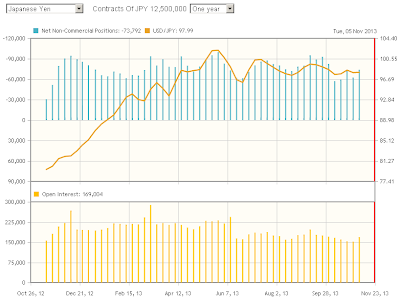I didn't post my fundamental analysis on the AUDJPY as I've been busy developing and backtesting a new mechanical system. The basic backtest is done. I'm now left with some optimisation, and perhaps exploring variants of this system.
The AUDJPY is traditionally popular for carry trading, due to the interest rate differential between the Reserve Bank of Australia and the Bank of Japan. Basically you borrow JPY at a lower interest rate to buy AUD to lend at a higher interest rate, and since the interest rate on AUD has traditionally been much higher than the JPY, you pocket the interest rate difference. Most currency traders use leverage. Now suppose your leverage is 100x, a 4% interest rate differential with 100x leverage will now provide you with a 400% return on your investment. If the price of the AUD rises against the JPY, you will also profit from capital appreciation. Hence the popularity of the carry trade.
Interest is typically collected each day at the close of the NY session. This system has you buying the AUDJPY just seconds before the NY close during a bullish trend on the daily chart. Not only will you collect the overnight carry, but bullish momentum should see you profit from a higher AUD in the next day or two.
To identify a bullish trend, all I look for is a bullish candle that appears above the 21 EMA without touching it, and the close of the candle must be within the top 50% of the candle. Here are some examples over the last few months (the dotted line is the 21 EMA. Notice no contact between the candles and the 21 EMA. If there is contact, then I assume the market is ranging and you stay out).
For purposes of the backtest, my entry price is the closing price of the candle, since we are entering mere seconds before the NY close. My stop loss is at the bottom of the candle. My sample size was 826 trades, from late 2000 to November 2013. I used the broker Alpari for data, which generally aligns with the New York close.
According to my backtest, a 0.6:1 reward:risk ratio seems best. At 2% risk and a $10,000 starting balance, we get the following equity curve.
We get a very nice R^2.
For robustness sake, this is the equity curve for 0.5:1 reward:risk.
Here is the equity curve for 0.75:1 reward:risk.
So we can see that minor changes to the R:R ratio don't break the system, which is a good indicator of robustness. Also note that these equity curves only graph the profit and loss from the trades themselves. It doesn't include the positive carry that we collect from each trade. If we include the positive carry, our equity curves will look even more healthy, but I haven't figured a way to calculate historical carry rates accurately. Anyway, it looks as if the system itself will generate profit without the need for carry.
Now having said all that, I'm not a big believer in pure mechanical trading anymore. My current philosophy is:
a) generate mechanical systems that can make money if simply traded "as is"
b) analyse market sentiment and fundamentals
c) if your analysis lines up with the logic of your mechanical system, open a trade
So with this system, I simply wouldn't be opening longs just for the heck of it. If I feel there are good reasons for the AUD to rise, then this mechanical system should give you a good return.
Anyway, this is all preliminary. I would like to do some further optimisation and tinkering on this system so it doesn't have my seal of approval yet. I'm just posting this to hopefully generate some ideas from you guys. :)


















































